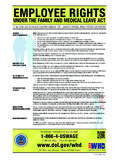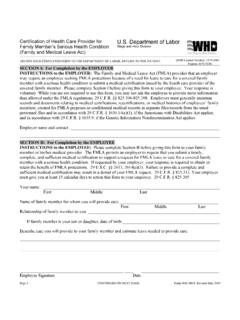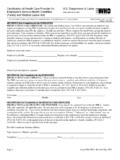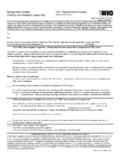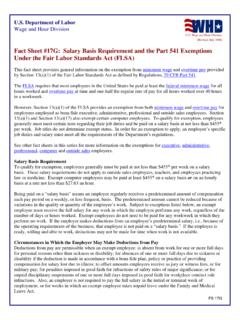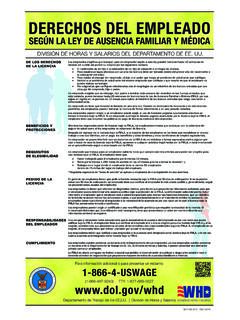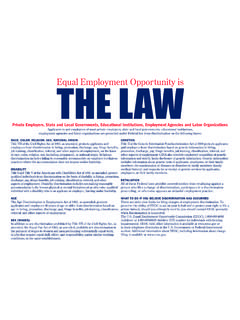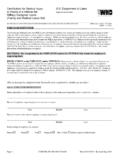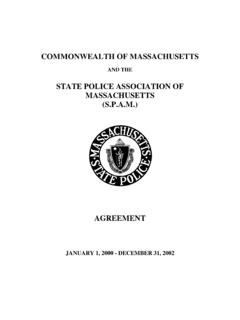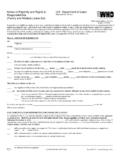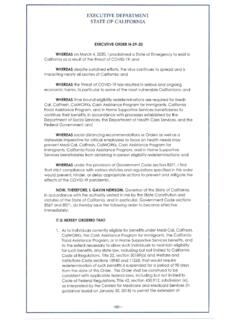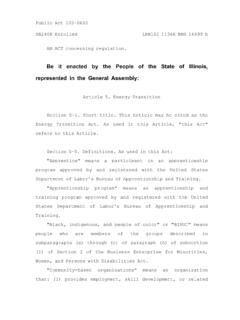Transcription of DIGITAL REFERENCE GUIDE - DOL
1 TO THE fair labor standards ACTDIGITAL REFERENCE GUIDEWAGE AND HOUR DIVISIONUNITED STATES DEPARTMENT OF LABORTOLL-FREE: 1-866-487-9243 (1-866-4US-WAGE)TDD: REFERENCE GUIDE to the fair labor standards Act (FLSA)ii13579111315171921232527 DIGITAL REFERENCE GUIDE to the fair labor standards Act (FLSA)iiDigital REFERENCE GUIDE to the fair labor standards Act (FLSA)iiDigital REFERENCE GUIDE to the fair labor standards Act (FLSA)iiDigital REFERENCE GUIDE to the fair labor standards Act (FLSA)iiDigital REFERENCE GUIDE to the fair labor standards Act (FLSA)iiWHO IS COVEREDMINIMUM WAGEEXEMPTIONSYOUTH EMPLOYMENTTERMS USED IN THE FLSARECORDKEEPINGNURSING MOTHERSCOMPUTING OVERTIMEENFORCEMENTRETALIATION PROHIBITEDOTHER WHD labor LAWSSBREFABASIC WAGE STANDARDSEQUAL PAYThe fair labor standards Act (FLSA) establishes minimum wage, overtime pay, recordkeeping, and child labor standards affecting full-time and part-time workers in the private sector and in federal, state, and local Wage and Hour Division (WHD)
2 Of the Department of labor (DOL) administers and enforces the FLSA with respect to private employment, state and local government employment, and federal employees of the Library of Congress, Postal Service, Postal Rate Commission, and the Tennessee Valley Authority. The FLSA is enforced by the Office of Personnel Management for employees of other Executive Branch agencies, and by the Congress for covered employees of the Legislative rules apply to state and local government employment involving fire protection and law enforcement activities, volunteer services, and compensatory time off instead of cash overtime the Wage and Hour Division confidentially with questions, or for more information at 866-4US-WAGE, or Trained professionals are available to help contained in this publication is in the public domain and may be reproduced fully or partially, without permission of the federal REFERENCE GUIDE to the fair labor standards Act (FLSA)113579111315171921232527^Return to Table of ContentsCovered, nonexempt workers are entitled to a minimum wage of $ per hour effective July 24, 2009.
3 Special provisions apply to workers in American Samoa and the Commonwealth of the Northern Mariana Islands. Nonexempt workers must be paid overtime pay at a rate of not less than one and one-half times their regular rates of pay after 40 hours of work in a required by the FLSA are due on the regular payday for the pay period covered. Deductions made from wages for such items as cash or merchandise shortages, employer-required uniforms, and tools of the trade, are not legal to the extent that they reduce the wages of employees below the minimum rate required by the FLSA or reduce the amount of overtime pay due under the FLSA contains some exemptions from these basic standards . Some apply to specific types of businesses; others apply to specific kinds of the FLSA does set basic minimum wage and overtime pay standards and regulates the employment of minors, there are a number of employment practices which the FLSA does not example, the FLSA does not require:(1) vacation, holiday, severance, or sick pay;(2) meal or rest periods, holidays off, or vacations;(3) premium pay for weekend or holiday work;(4) pay raises or fringe benefits; or(5) a discharge notice, reason for discharge, or immediate payment of final wages to terminated FLSA does not provide wage payment or collection procedures for an employee s usual or promised wages or commissions in excess of those required by the FLSA.
4 However, some states do have laws under which such claims (sometimes including fringe benefits) may be , the FLSA does not limit the number of hours in a day or days in a week an employee may be required or scheduled to work, including overtime hours, if the employee is at least 16 years above matters are for agreement between the employer and the employees or their authorized WAGE STANDARDSD igital REFERENCE GUIDE to the fair labor standards Act (FLSA)213579111315171921232527^Return to Table of ContentsDigital REFERENCE GUIDE to the fair labor standards Act (FLSA)2 Order WHD publications DOL on YouTubeDigital REFERENCE GUIDE to the fair labor standards Act (FLSA)2 DIGITAL REFERENCE GUIDE to the fair labor standards Act (FLSA)2 ADDITIONAL RESOURCES >WHD FLSA information page>WHD FLSA advisor tool>WHD new and small business information page>FLSA rights poster: minimum wage>WHD fact sheet 1069: basic informationDigital REFERENCE GUIDE to the fair labor standards Act (FLSA)313579111315171921232527^Return to Table of ContentsWHO IS COVEREDAll employees of certain enterprises having workers engaged in interstate commerce, producing goods for interstate commerce, or handling, selling, or otherwise working on goods or materials that have been moved in or produced for such commerce by any person, are covered by the covered enterprise is the related activities performed through unified operation or common control by any person or persons for a common business purpose and.
5 (1) whose annual gross volume of sales made or business done is not less than $500,000 (exclusive of excise taxes at the retail level that are separately stated); or(2) is engaged in the operation of a hospital, an institution primarily engaged in the care of the sick, the aged, or the mentally ill who reside on the premises; a school for mentally or physically disabled or gifted children; a preschool, an elementary or secondary school, or an institution of higher education (whether operated for profit or not for profit); or(3) is an activity of a public enterprise that was covered by the FLSA on March 31, 1990, and that ceased to be covered because of the revised $500,000 test, continues to be subject to the overtime pay, child labor and recordkeeping provisions of the of firms which are not covered enterprises under the FLSA still may be subject to its minimum wage, overtime pay, recordkeeping, and child labor provisions if they are individually engaged in interstate commerce or in the production of goods for interstate commerce, or in any closely-related process or occupation directly essential to such production.
6 Such employees include those who: work in communications or transportation; regularly use the mails, telephones, or telegraph for interstate communication, or keep records of interstate transactions; handle, ship, or receive goods moving in interstate commerce; regularly cross state lines in the course of employment; or work for independent employers who contract to do clerical, custodial, maintenance, or other work for firms engaged in interstate commerce or in the production of goods for interstate service workers such as day workers, housekeepers, chauffeurs, cooks, or full-time babysitters are covered if:(1) their cash wages from one employer in calendar year 2010 are at least $1,700 (this calendar year threshold is adjusted by the Social Security Administration each year); or(2) they work a total of more than eight hours a week for one or more REFERENCE GUIDE to the fair labor standards Act (FLSA)413579111315171921232527^Return to Table of ContentsDigital REFERENCE GUIDE to the fair labor standards Act (FLSA)4 Order WHD publications DOL on YouTubeADDITIONAL RESOURCES >WHD coverage and employment status advisor tool>WHD fact sheet 7: state and local government>WHD fact sheet 14: coverage>WHD fact sheet 14a: non-profit organizations>WHD fact sheet 15: tipped employees>WHD fact sheet 15a: ownership of tips>WHD fact sheet 33: residential care facilities>FLSA rights poster.
7 Minimum wage for state and local government employeesDigital REFERENCE GUIDE to the fair labor standards Act (FLSA)513579111315171921232527^Return to Table of ContentsMINIMUM WAGEY outh Minimum WageA minimum wage of not less than $ an hour is permitted for employees under 20 years of age during their first 90 consecutive calendar days of employment with an employer. Employers are prohibited from taking any action to displace employees in order to hire employees at the youth minimum wage. Also prohibited are partial displacements such as reducing employees hours, wages, or employment HomeworkThe performance of certain types of work in an employee s home is prohibited under the law unless the employer has obtained prior certification from DOL. Restrictions apply in the manufacture of knitted outerwear, gloves and mittens, buttons and buckles, handkerchiefs, embroideries, and jewelry (where safety and health hazards are not involved).
8 The manufacture of women s apparel (and jewelry under hazardous conditions) is generally prohibited. If you have questions on whether a certain type of work is restricted, or who is eligible for a homework certificate, or how to obtain a certificate, you may contact the local WHD Wage ProvisionsThe FLSA provides for the employment of certain individuals at wage rates below the statutory minimum. Such individuals include student-learners (vocational education students), as well as full-time students in retail or service establishments, agriculture, or institutions of higher education. Also included are individuals whose earning or productive capacity is impaired by a physical or mental disability, including those related to age or injury, for the work to be performed. Employment at less than the minimum wage is authorized to prevent curtailment of opportunities for employment.
9 Such employment is permitted only under certificates issued by EmployeesTipped employees are individuals engaged in occupations in which they customarily and regularly receive more than $30 a month in tips. Employers may consider tips as part of wages, but employers must still pay at least $ an hour in direct employer who elects to use the tip credit provision must inform the employee in advance, and must be able to show that the employee receives at least the applicable minimum wage (see above) when direct wages and the tip credit claimed are combined. If an employee s tips combined with his/her direct wages of at least $ an hour do not equal the minimum hourly wage, the employer must make up the difference. Also, employees are entitled to keep all of their tips, except to the extent that they participate in a valid tip pooling or sharing FacilitiesThe reasonable cost or fair value of board, lodging, or other facilities customarily furnished by the employer for the employee s benefit may be considered part of REFERENCE GUIDE to the fair labor standards Act (FLSA)613579111315171921232527^Return to Table of ContentsDigital REFERENCE GUIDE to the fair labor standards Act (FLSA)6 Order WHD publications DOL on YouTubeADDITIONAL RESOURCES >Employment law GUIDE : minimum wage and overtime pay>Minimum wage Q and A>State minimum wage map and tool>WHD special employment information page>WHD industrial homework information page>WHD fact sheet 16: deductions from wages for uniforms and other facilities>WHD fact sheet 24: homeworkers>WHD fact sheet 32.
10 youth minimum wage>FLSA rights poster: minimum wage>FLSA rights poster: subminimum wagesDigital REFERENCE GUIDE to the fair labor standards Act (FLSA)713579111315171921232527^Return to Table of ContentsEXEMPTIONSSome employees are exempt from the overtime pay provisions or both the minimum wage and overtime pay exemptions are generally narrowly defined under the FLSA, an employer should carefully check the exact terms and conditions for each. Detailed information is available from local WHD are examples of exemptions which are illustrative, but not all-inclusive. These examples do not define the conditions for each from Both Minimum Wage and Overtime Pay(1) Executive, administrative, and professional employees (including teachers and academic administrative personnel in elementary and secondary schools), outside sales employees, and employees in certain computer-related occupations (as defined in DOL regulations)(2) Employees of certain seasonal amusement or recreational establishments, employees of certain small newspapers, seamen employed on foreign vessels, employees engaged in fishing operations, and employees engaged in newspaper delivery(3) Farmworkers employed by anyone who used no more than 500 man-days of farm labor in any calendar quarter of the preceding calendar year(4) Casual babysitters and persons employed as companions to the elderly or infirmExemptions from Overtime Pay Only(1)
